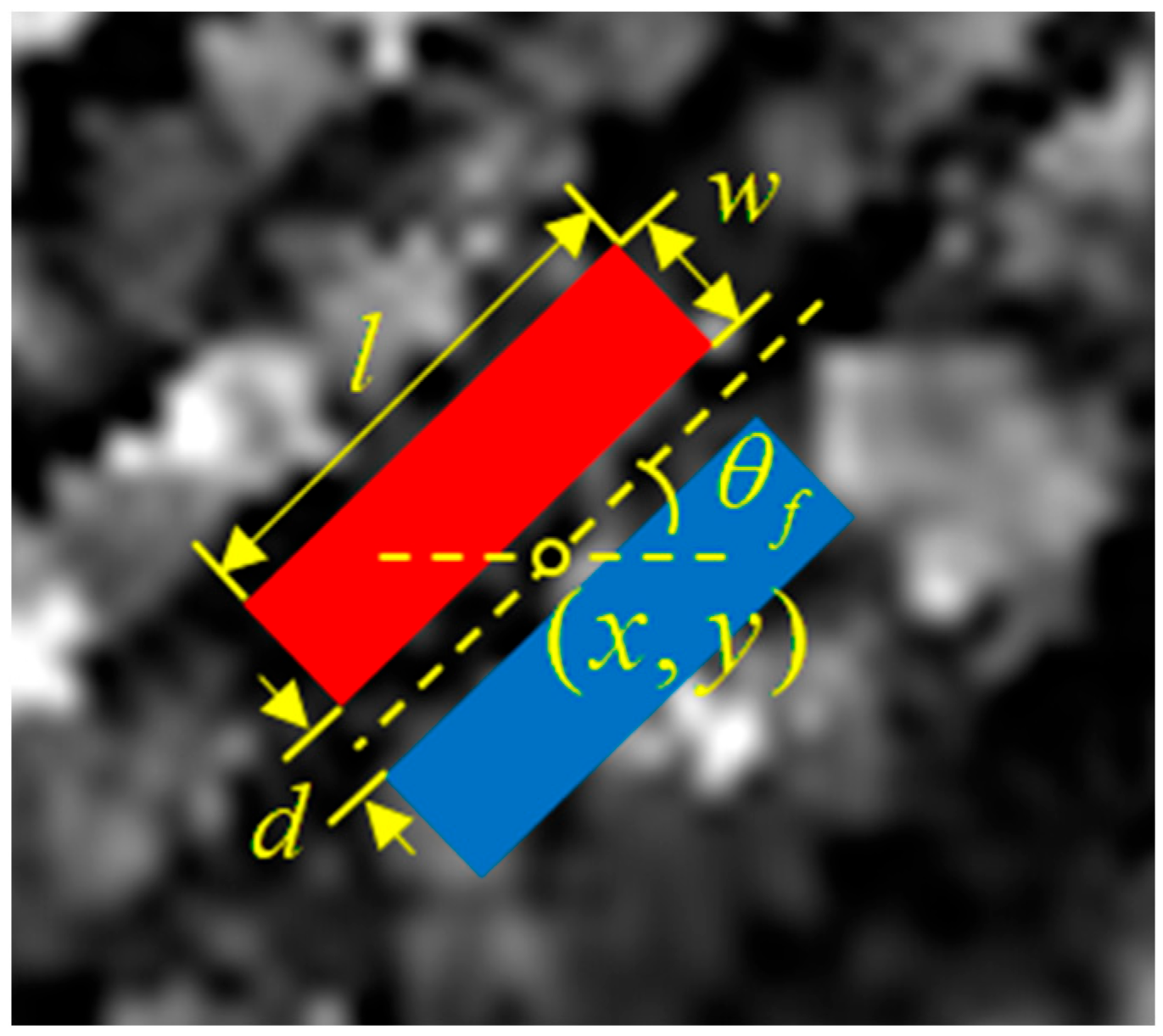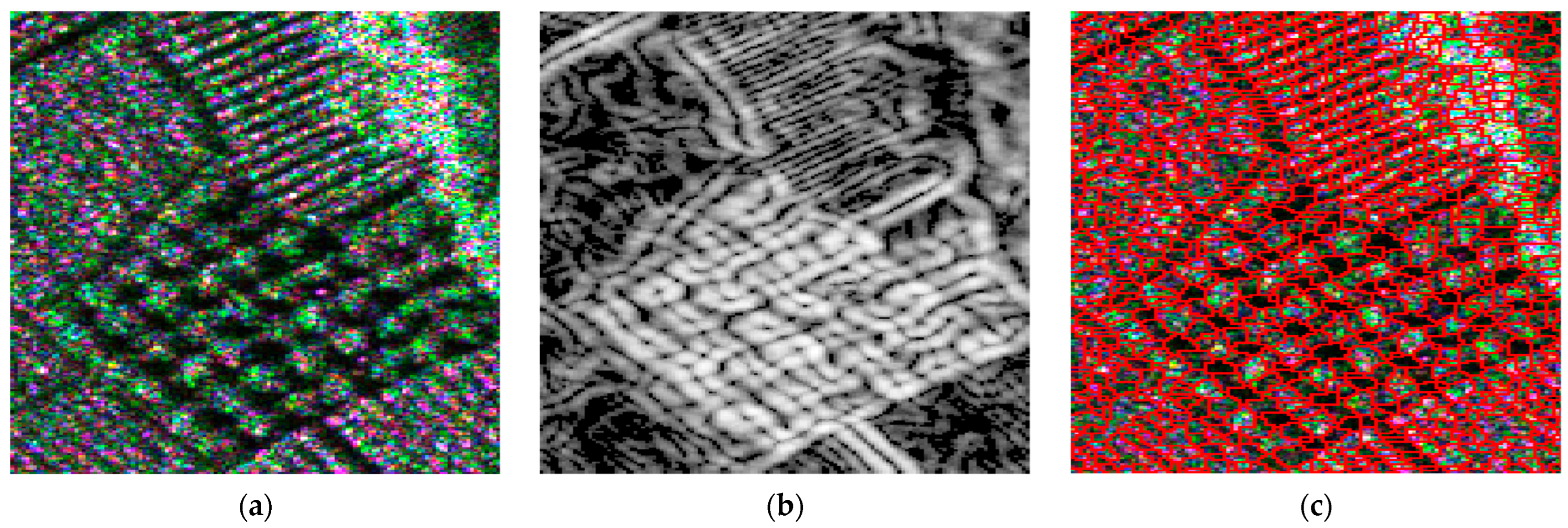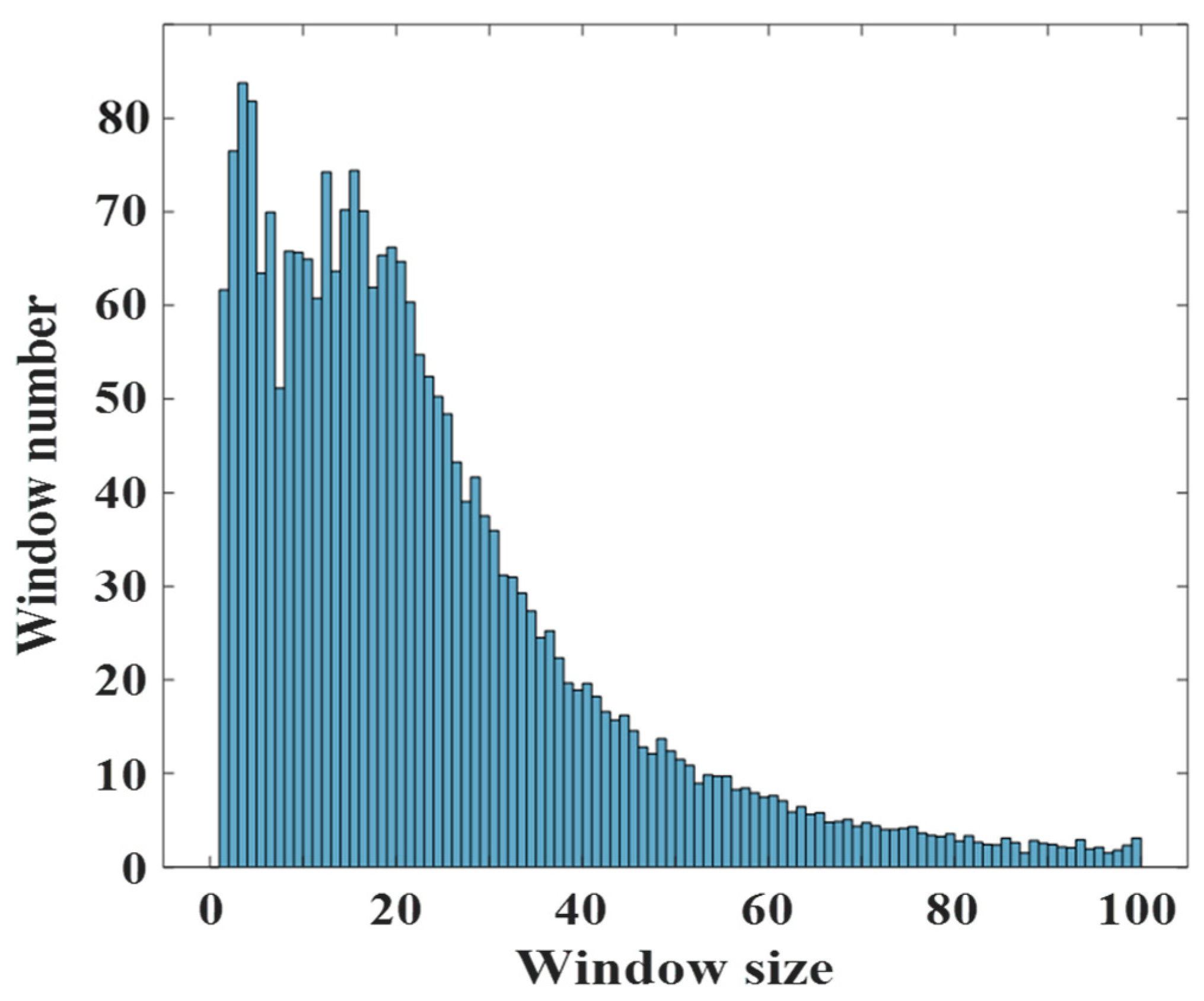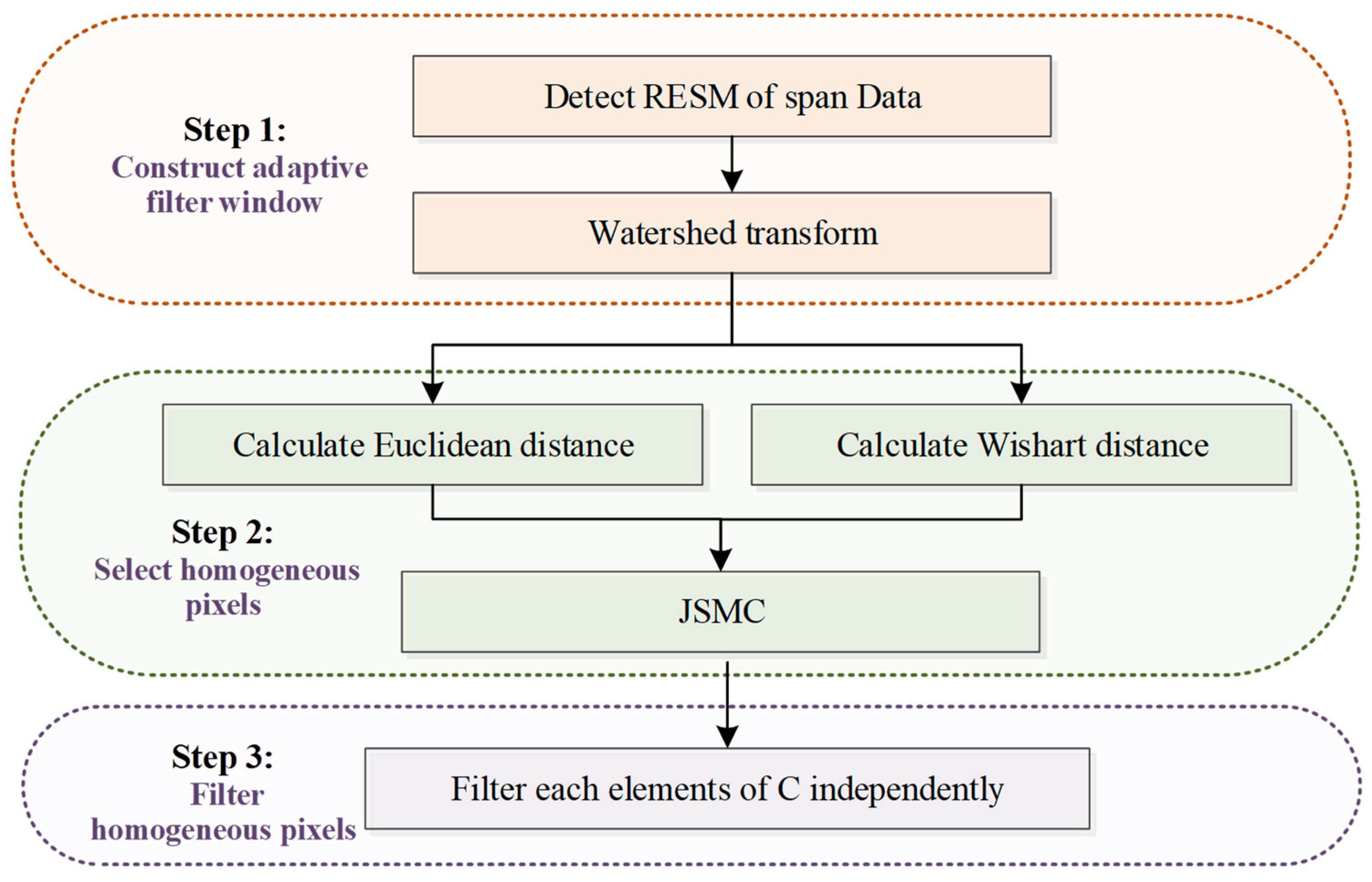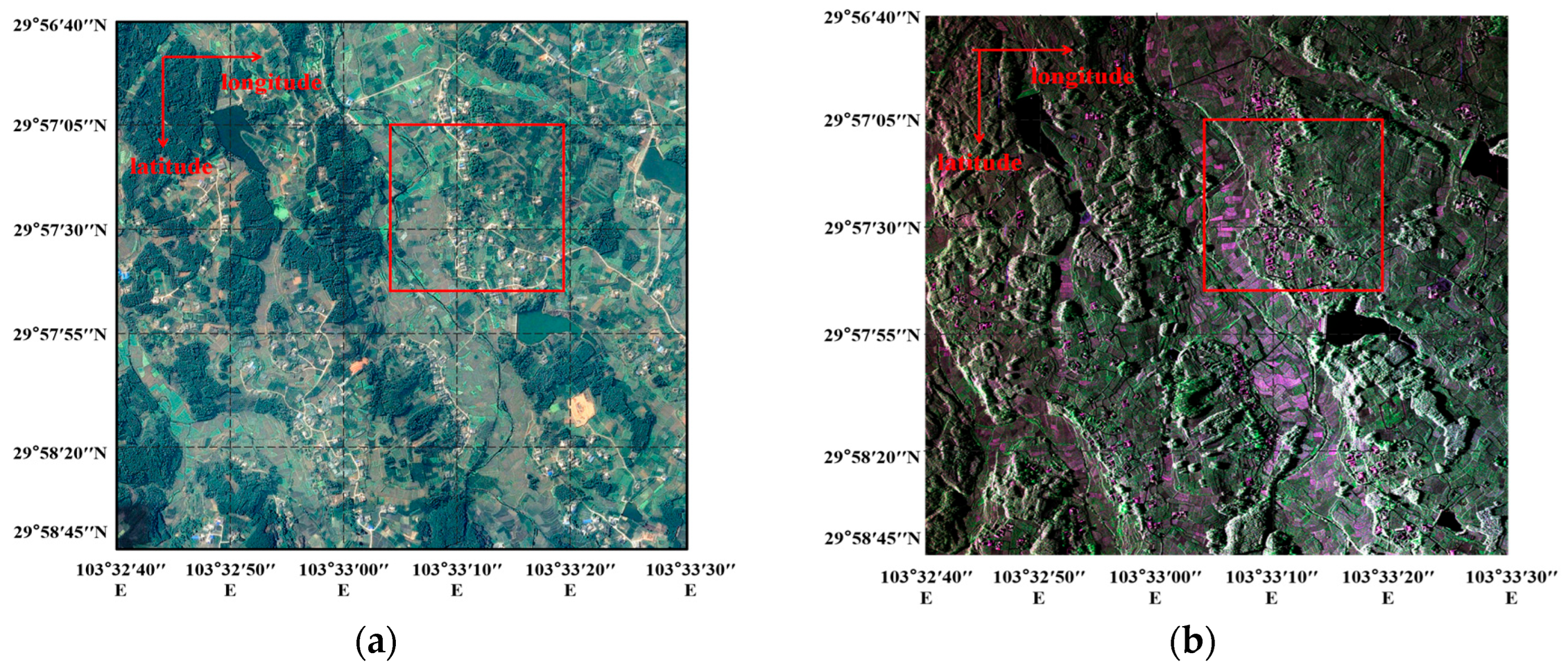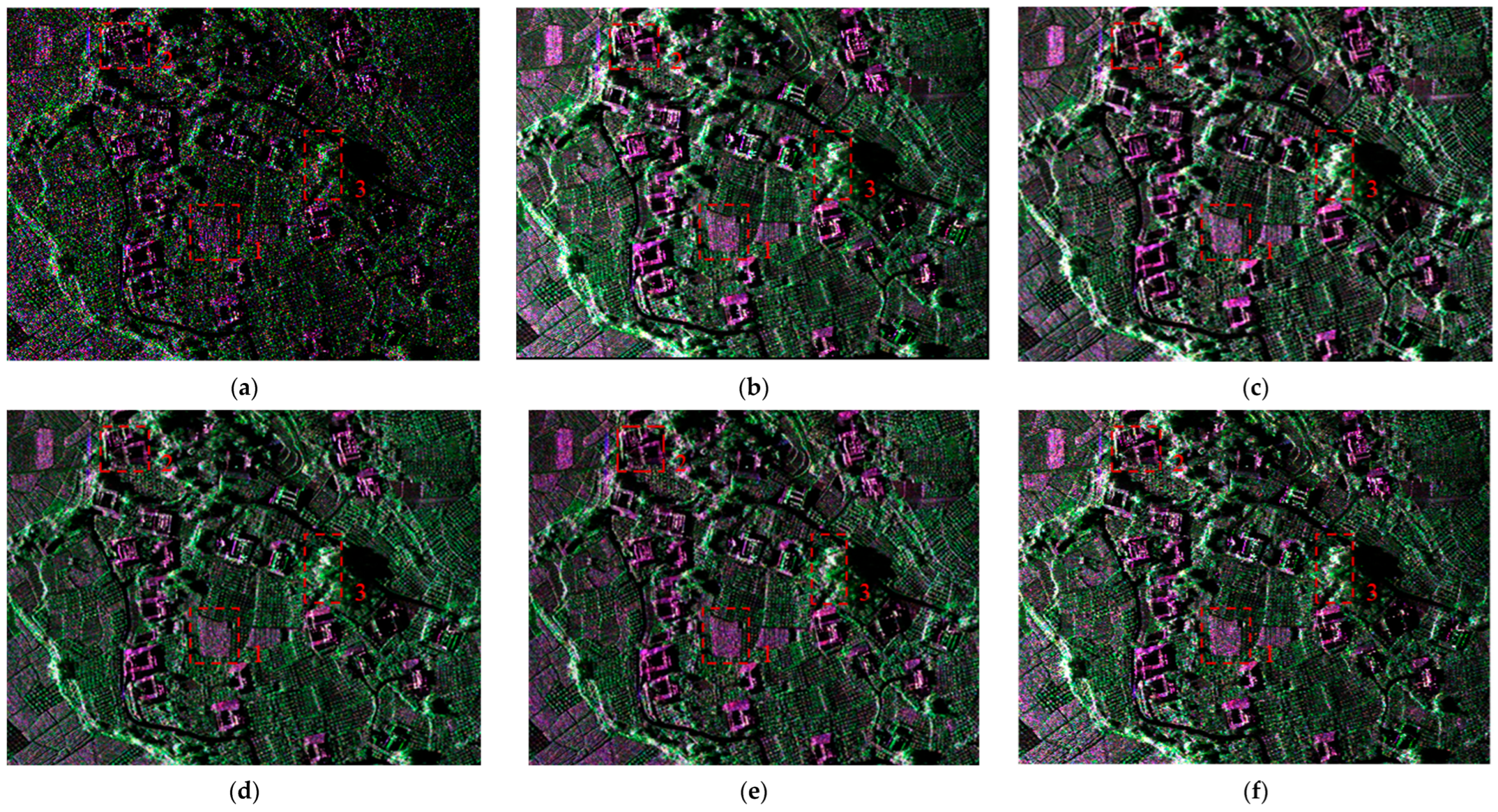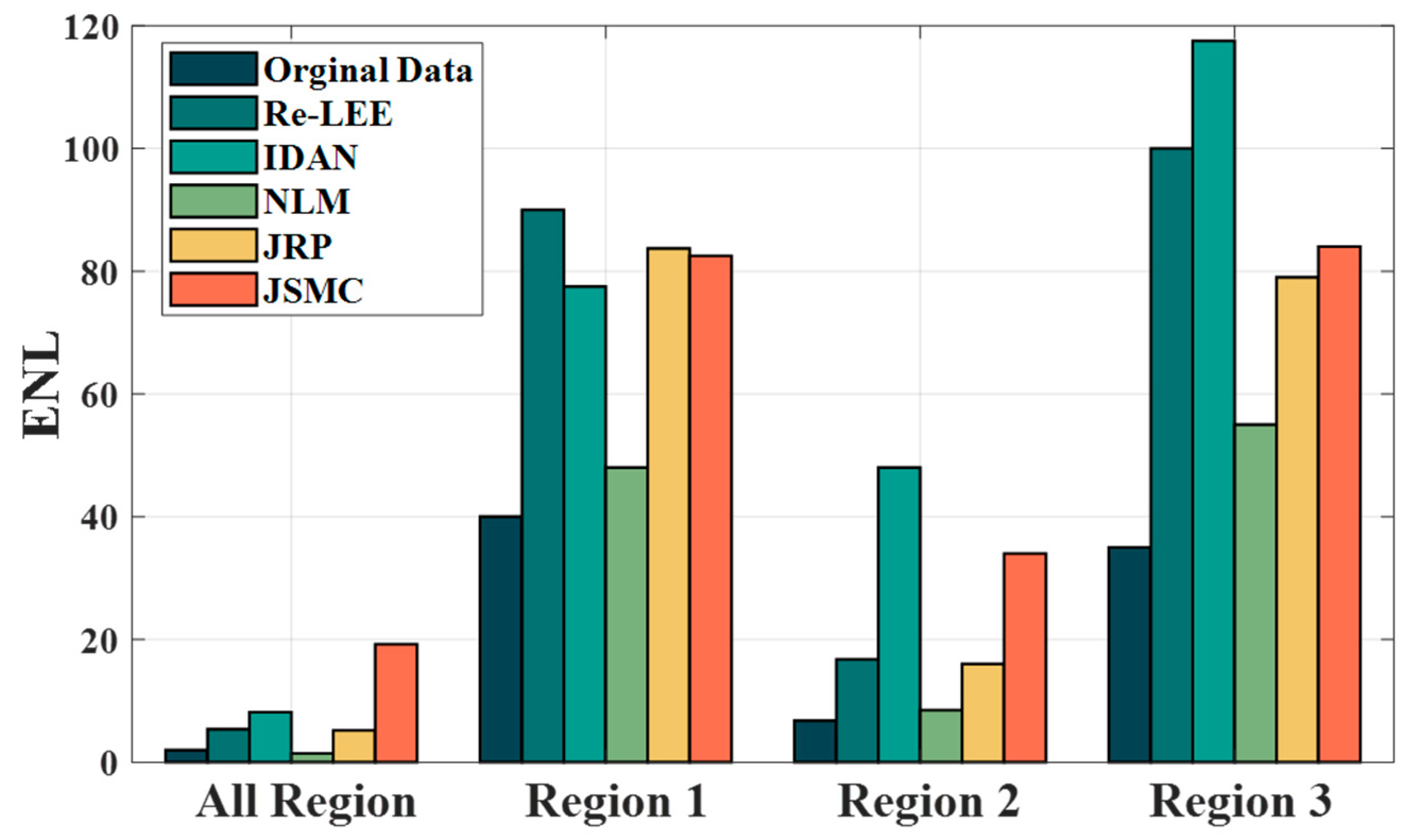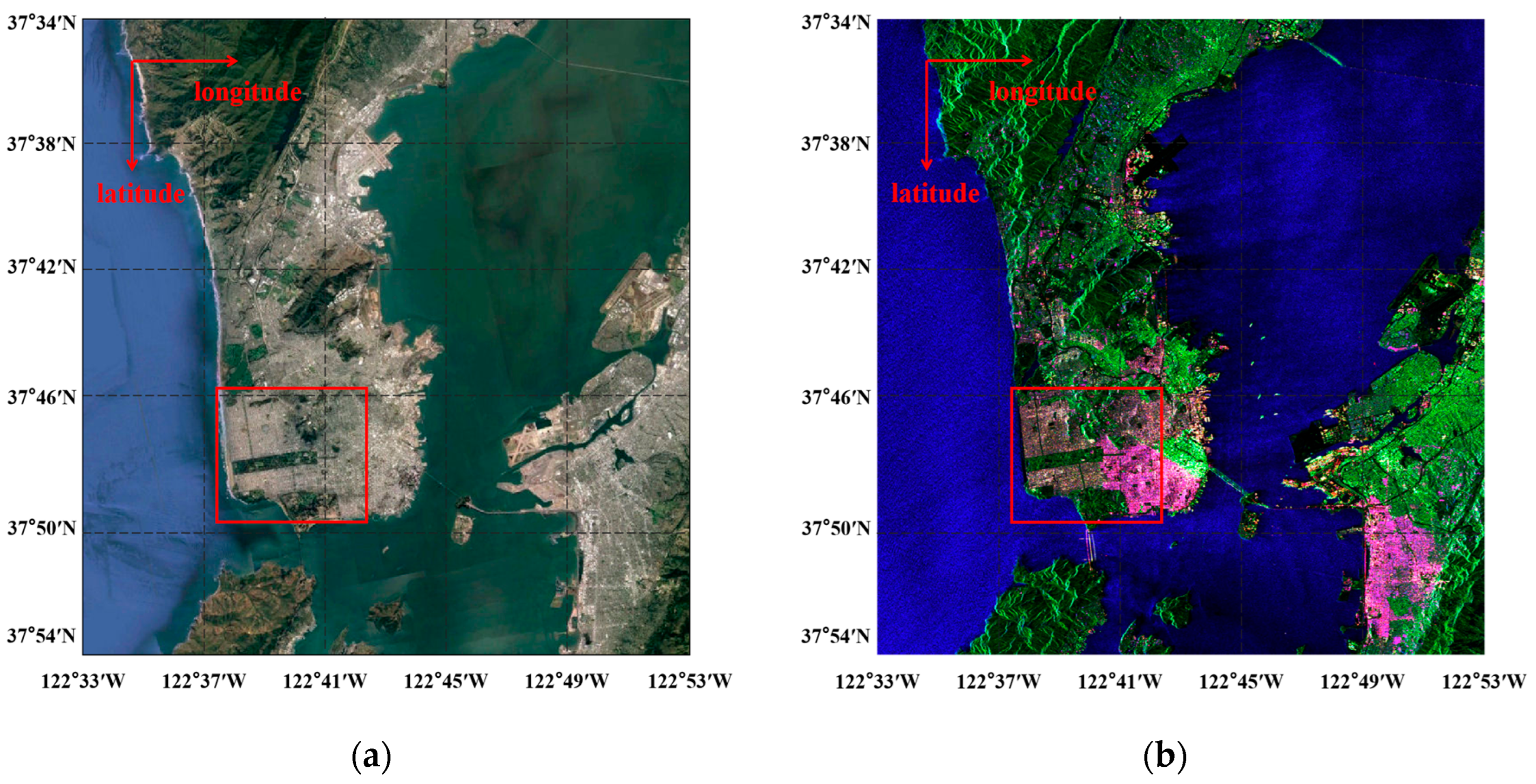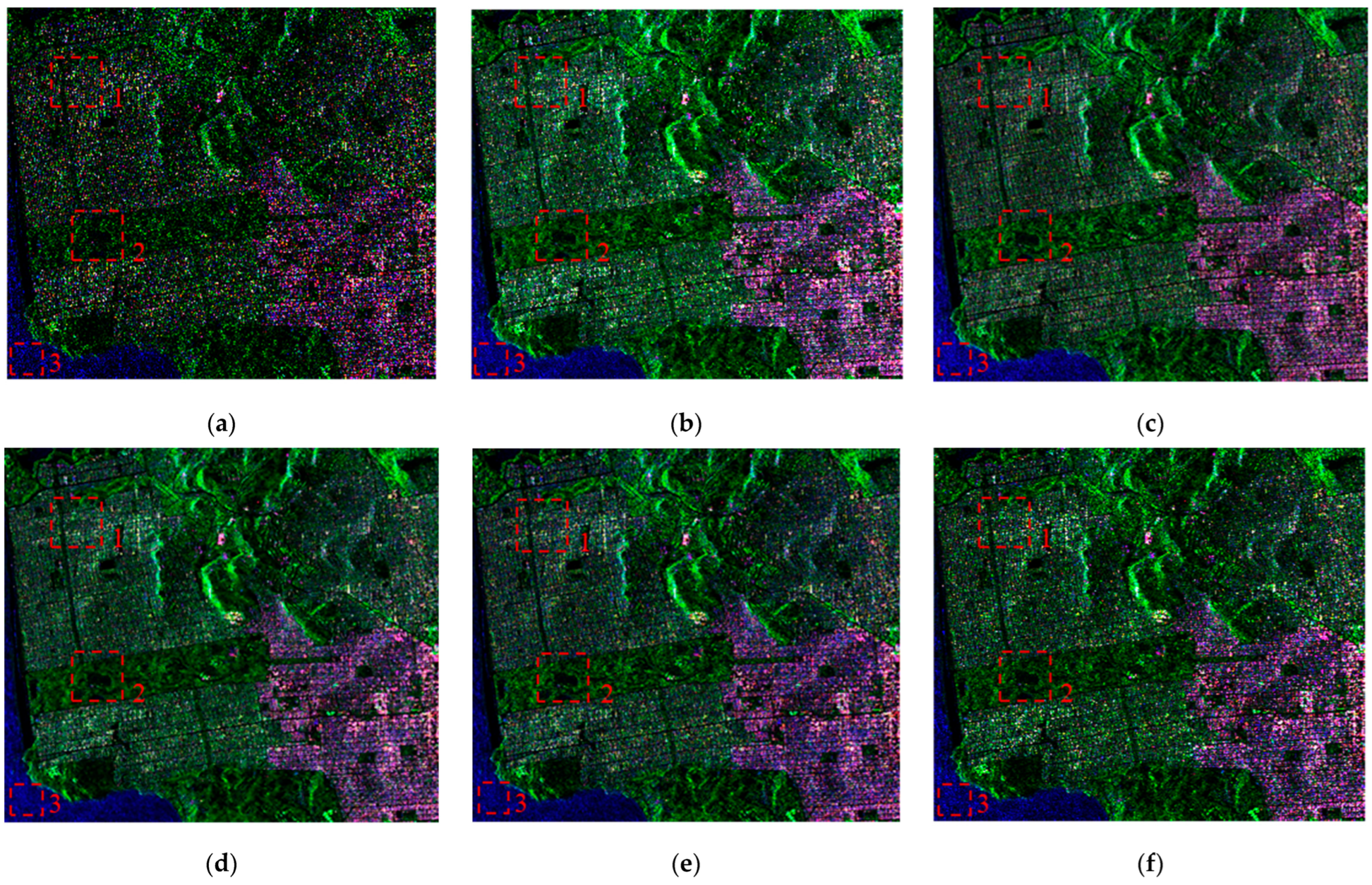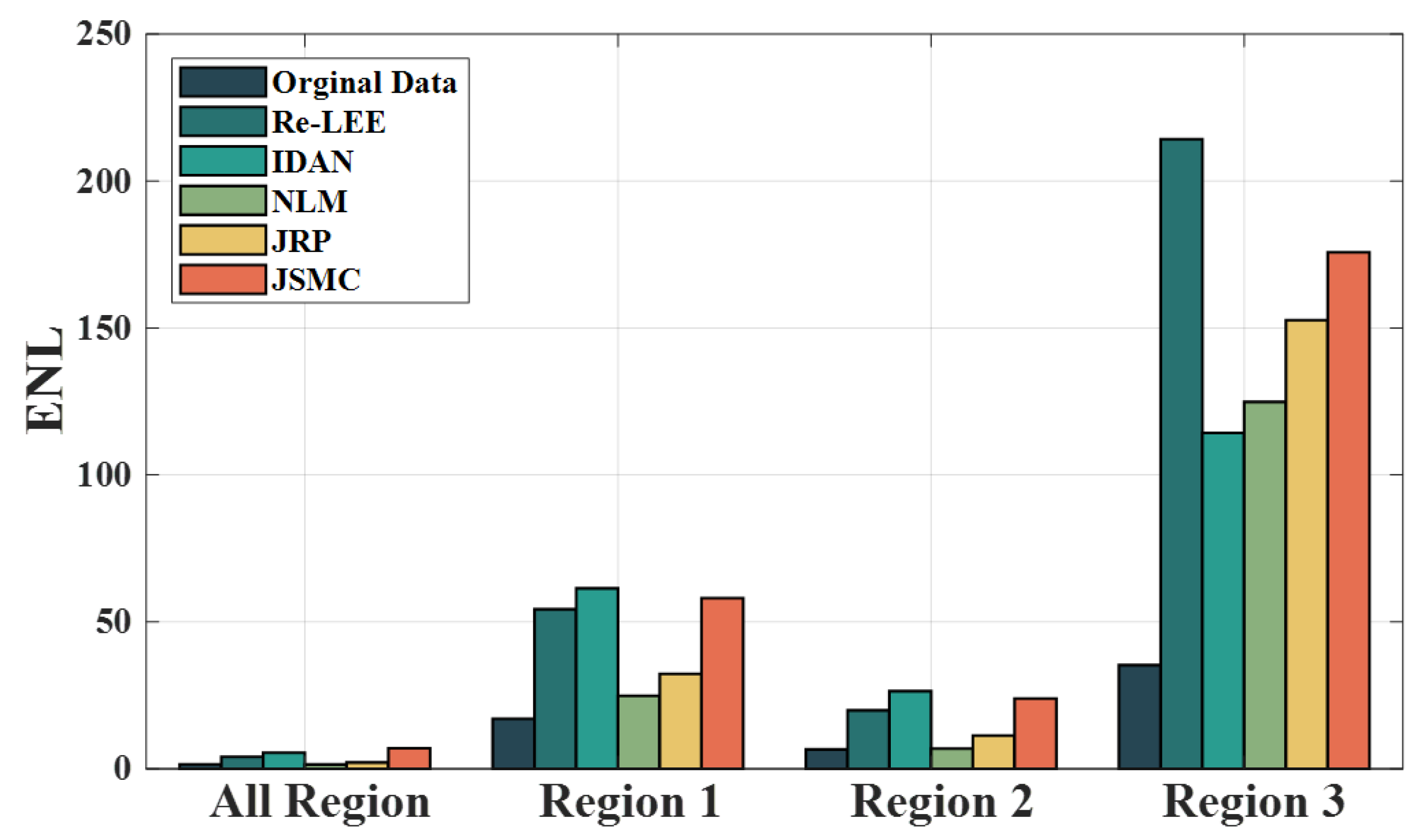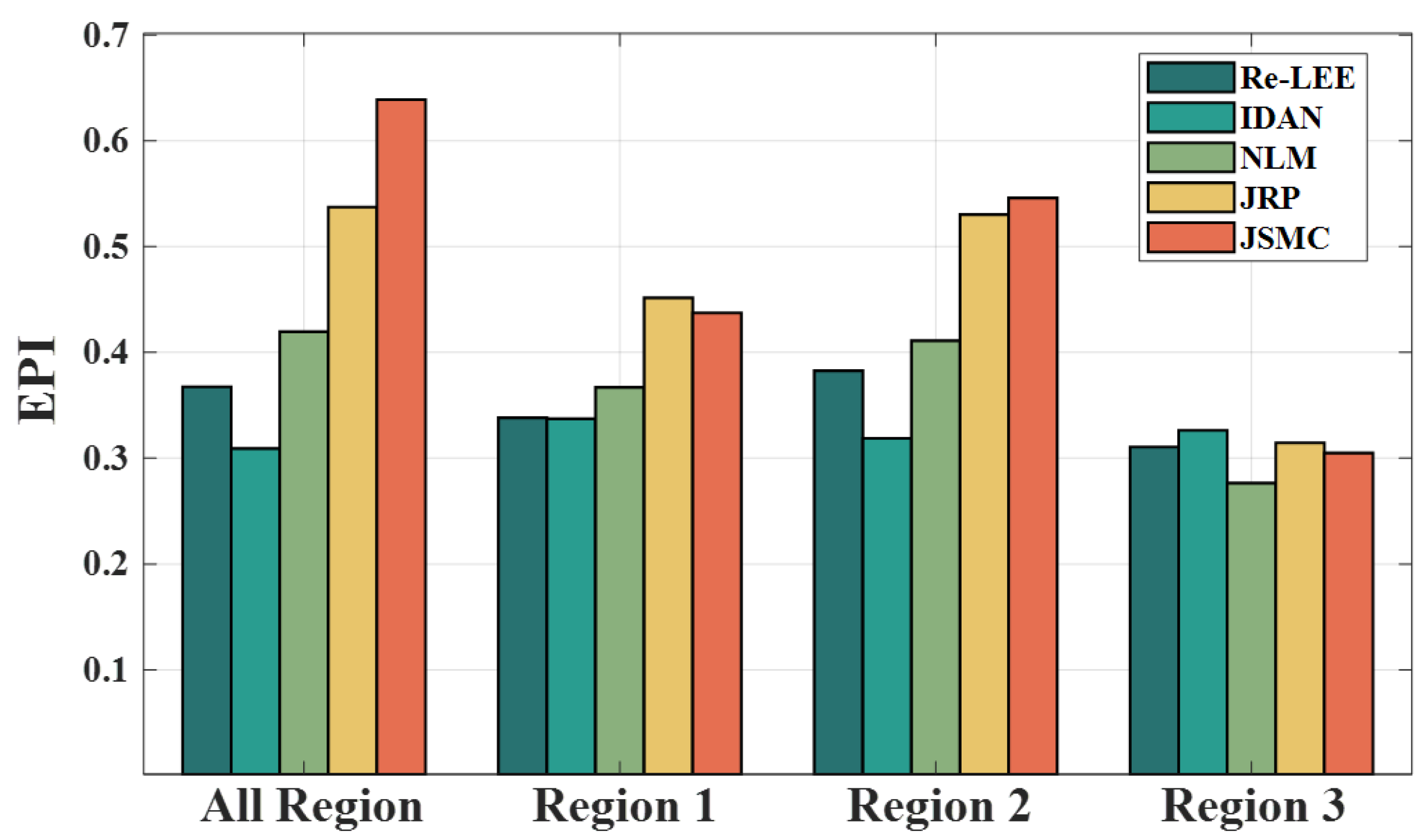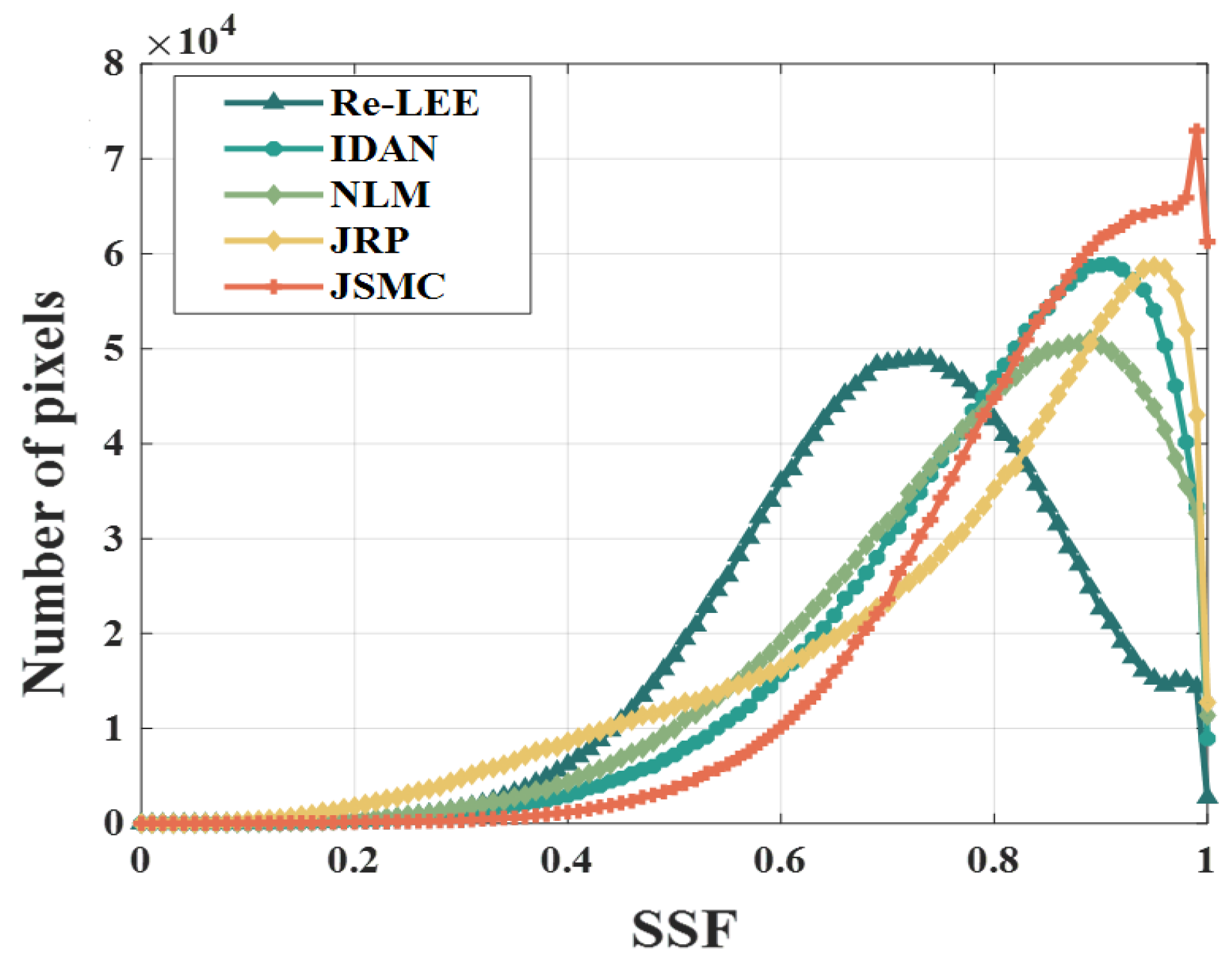1. Introduction
Polarimetric Synthetic Aperture Radar (PolSAR) [
1] utilizes electromagnetic waves to transmit and receive different polarization modes, which allows it to be highly sensitive to the structural and electromagnetic scattering characteristics of targets [
2]. It is widely used in scenarios such as image classification, target detection, and hidden target monitoring [
3,
4,
5,
6]. However, the coherent imaging mechanism of SAR still leads to speckle noise in PolSAR data, complicating the data interpretation by reducing the accuracy of image segmentation and classification. Therefore, speckle suppression is crucial for the reformation of PolSAR data quality.
The earliest PolSAR speckle filter was derived from a single-polarization SAR filter, which employs the multi-look averaging method for speckle suppression [
1]. Multi-look processing is simple and effective, but at the cost of resolution degradation and spatial detail loss. Therefore, specialized filters for PolSAR data are being explored. The Polarimetric Whitening Filter (PWF) [
7] minimizes speckle noise by combining the elements of an optimal-polarization covariance matrix. To reduce the speckle of the three polarimetric channels (HH, HV and VV), J.S. Lee et al. [
8] proposed the Optimal Weighted Filter. This filter smooths the PolSAR data linearly based on the multiplicative noise model and Minimum Mean Square Error (MMSE) criterion. Subsequently, Lee proposed the most classic PolSAR spatial filtering algorithm: the Refined Lee Filter (Re-Lee Filter) [
9]. The Re-Lee Filter overcomes the restrictions of previous speckle filters by employing span data to determine the edge direction window and related parameters, while also considering speckle suppression and polarization information preservation. Since then, many scholars have carried out in-depth research on the filter and further improved the estimation accuracy of filtering parameters. G. Vasile [
10] proposes an adaptive neighborhood (IDAN) filter that combines the region growing technique with the Re-Lee filter. López-Martínez et al. [
11,
12] explore the realm of spatially nonstationary and anisotropic texture analysis in SAR images and propose a multiplicative-additive speckle noise model to enhance the characterization of speckle effects, particularly on the off-diagonal elements, which are elements of the covariance matrix. Guo [
13] and Wu [
14] incorporated three-component and four-component decomposition into a PolSAR Re-Lee Filter. In 2018, Xie [
15] extended the boundary window of the Re-Lee Filter, simultaneously incorporating statistical models and polarimetric scattering similarity, leading to notable performance improvements. The rise of the Non-Local Mean (NLM) filter has brought a fresh insight to the field of spatial filtering algorithms. In 2009, the concept of Probabilistic Patch-Based (PPB), which is based on noise distribution properties, was introduced in order to determine similarity [
16]. Then, Deledalle extended the NLM filter for denoising PolSAR data [
17]. In 2015 and 2016, Wu, et al. [
18] and Sharifymoghaddam [
19] proposed adjustments to the similarity measurement in the NLM algorithm, making it more appropriate for SAR data. NLM filters make use of a wider range of image structure information to estimate similarity and generally perform better at preserving texture information. Nevertheless, they do not demonstrate exceptional performance in maintaining polarimetric properties. To address this, Shen [
20] introduced an adaptive NLM filter with shape-adaptive patch matching (ANLM). However, it tends to have a higher algorithmic complexity and lower computational efficiency, making it less practical in large-scale data preprocessing.
Recent advances in machine learning and neural networks have demonstrated great potential for reducing speckle noise in PolSAR data. In a study by Harold C. Burger et al. [
21], data denoising was successfully achieved by applying a multilayer perceptron (MLP) to map data blocks and a large database for training. Further research performed by G. Chierchia [
22] utilizes a convolutional neural network (CNN) for SAR data denoising. This network applies a residual learning strategy to remove speckle components from the noise data and has achieved impressive results with both synthetic and real SAR data. G. Adugna [
23] proposes a multi-stream complex-valued fully convolutional network (CV-deSpeckNet) that reduces speckle and estimates the PolSAR covariance matrix effectively, demonstrating the feasibility of complex-valued deep learning for PolSAR speckle suppression. These filters train deep neural networks on large PolSAR datasets to identify underlying patterns and structures to denoise the data. Despite their high efficacy, it is important to note that these filters require a substantial amount of labeled data and computational resources.
The analysis and review above show that PolSAR speckle suppression has attracted much attention. Conventional spatial domain filters still play a crucial role in practical data processing applications. However, these techniques still have limitations on how accurately they can identify homogeneous pixels. In terms of window selection, traditional windows such as fixed rectangular windows, edge template windows, and adaptive windows are not able to accurately represent the true nature of the ground objects. In terms of judgment criteria, most of the existing algorithms are based on a simple multiplicative speckle noise model and Gaussian distribution statistics, e.g., the confidence interval in the Sigma filter algorithm [
24] and the variation coefficient used by the Re-Lee filter [
25]. These factors result in errors in the selection of homogeneous pixels and make it challenging to achieve a balance between speckle suppression, preservation of polarization information, and edge structure. To resolve these issues, this paper proposes an adaptive PolSAR speckle filter based on the joint similarity measure criterion (JSMC). Firstly, the multi-directional ratio edge detector and watershed transform are utilized to efficiently acquire an irregular filtering window. Subsequently, we propose the JSMC, which combines spatial-domain and extreme-domain similarity measures to accurately select homogeneous pixels while preserving data characteristics. Finally, statistical averaging is performed on the homogeneous pixels in order to achieve speckle filtering.
The remainder of this paper is structured as follows: The main principles and methods of PolSAR filtering are analyzed in
Section 2. In
Section 2.1, the fundamental concepts of PolSAR data and the criteria for filter design are briefly introduced. In
Section 2.2, the adaptive PolSAR filter based on JSMC is detailed. Based on the analysis above, the complete flow chart of this method is outlined in
Section 2.3. The experimental results obtained from both airborne and spaceborne data are presented in
Section 3. The performance of the method is further analyzed and discussed in
Section 4. Finally, the paper concludes with a summary of its full content in
Section 5.
2. Principle and Method of PolSAR Speckle Filtering
2.1. PolSAR Speckle Filtering
PolSAR obtains the medium complex scattering matrix
with quad polarizations between the transmitting and the receiving channels. The scattering matrix in the linear polarization base can be expressed as:
The subindices
and
are the horizontal and vertical orthogonal polarization, respectively.
is the scattering element of horizontal transmitting and horizontal receiving polarization, and the other three elements are defined similarly. Based on the hypothesis of reciprocal backscattering case,
. The polarimetric scattering information can be represented vectorially by Pauli basis
or Lexicographic basis
as [
26]:
where, the superscript
denotes the matrix transpose.
The span (or total power) of a pixel is an incoherent summation of three polarimetric channels (HH, HV and VV), which can be expressed as:
In order to eliminate the speckle caused by the coherent superposition of scattering unit echoes, SAR data are generally filtered by averaging several adjacent single-look pixels. Similarly, the polarization covariance matrix
or coherence matrix
, after speckle suppression is obtained from the PolSAR data, can be expressed as:
where,
is the number of the pixels chosen from the homogeneous region or the number of the nominal multi-look,
represents the spatial average of
pixels, the superscript
, and
denote the conjugate transpose and complex transpose.
The covariance matrix
and the coherence matrix
can be converted through
where,
PolSAR speckle filtering is mainly shown in the accurate statistics of polarization covariance matrix
or coherence matrix
. The guiding principles are as follows [
4].
Each element of the polarimetric covariance matrix or coherence matrix should be estimated by averaging the surrounding homogeneous pixels in a similar way to multi-look processing.
Each element of the polarization covariance matrix or coherence matrix must be filtered independently in the spatial domain. All elements of the covariance matrix should be filtered with the same weight.
The filtering should be adaptive and select a homogeneous area from neighboring pixels.
2.2. PolSAR Speckle Filter Based on Joint Similarity Measurement Criterion
The existing spatial PolSAR speckle filters are all implemented by selecting homogeneous pixels for average value. The difference between various filters is only in the selection window algorithm and the homogeneous pixel judgment standard. Considering the above two aspects, this paper will take two measures to ensure the speckle-filtering consequent: construct the irregular filtering window based on the target shape structure and retain the edge features and structure information to the maximum extent and construct JSMC to achieve the selection of homogeneous pixels.
2.2.1. Adaptive Filtering Window Construction
In order to preserve the edge features and structural information, this paper adopts a multi-directional ratio edge detector and watershed transform to construct an adaptive filter window. To prevent the interference of speckle noise with the detection of structural edges, this study employs rotated rectangular windows as edge detectors. An edge detector [
27] can be represented by the parameter
, and its structure is shown in
Figure 1. In
Figure 1,
is the length of the detector,
is the width of the detector,
is the width between two rectangles, and
is the direction of the detector. For a specific direction
, the average value of pixels in the rectangular area on both sides of pixel
is
and
, then the ratio edge strength map (RESM) of the pixel is defined as:
where
is uniformly sampled in
.
To avoid a large number of fragmented windows caused by local minima after watershed transform, this paper utilizes a threshold method to construct the RESM, i.e., in (9),
,
is the direction number of the edge detector.
is the α percentile value of the RESM histogram. The
is positively related to the size of the adaptive filtering window, which is the tradeoff between the reduction in speckle and the loss of edge structure. It can be determined according to the demand for filtering details. A larger
provides smoother speckle suppression but may blur fine details. If the texture needs to be preserved, a smaller value of
should be utilized. Finally, the watershed transform is performed on the threshold RESM to construct the adaptive filtering windows.
PolSAR span data is the weighted sum of each polarization channel, which can restrain the speckle to a certain extent, and its noise level is lower than that of any polarization channel. Therefore, this paper applies the span data for adaptive filtering window construction. In the following content, the results of adaptive filtering window construction for airborne data are given in
Figure 2. The data size is 300 × 300 pixels, and
is empirically taken as 20.
Figure 2a–c shows a Pauli decomposed diagram of airborne data, threshold RESM, and adaptive filtering windows, respectively. The region primarily consists of grapevines and citrus trees, with grapevines spaced 2–3 pixels apart and citrus trees spaced about 4–5 pixels apart. To ensure that the windows preserve the texture structure, it is certain that a portion of the windows will have smaller sizes, as is shown in
Figure 3. However, within the 300 × 300 pixel area of
Figure 2, there are a total of 1897 irregular windows, with an average size of 47 pixels, which is roughly equivalent to a 7 × 7 window size. And the window size mainly depends on the geometric structure of the scene, which is consistent with the subjective visual experience.
2.2.2. Joint Similarity Measurement Criterion
For SAR data, each pixel is expressed as complex data. For PolSAR data, each pixel is processed with a scattering matrix or covariance matrix, which contains intensity and polarimetric information. Most speckle suppression algorithms refer to the Refined Lee’s filtering idea when extending from SAR to PolSAR filtering, calculate the similarity between pixels to obtain homogeneous pixel areas using PolSAR span data, and then filter each element of the covariance matrix separately. However, it is necessary to retain the polarimetric properties of ground objects in PolSAR data, in addition to preserving the texture of the scene. At this point, the span data can no longer accurately reflect the polarimetric similarity between pixels.
In the practical application, the polarization covariance matrix and polarization coherence matrix contain all the polarization information from the data, which are the direct representations of the polarization scattering mechanism. The polarization classification and decomposition are also based on the above two matrices. To sum up, constructing a robust similarity measure parameter of a covariance matrix or coherence matrix is a significant issue for the polarization of homogeneous pixel selection. In this paper, the Wishart distance between the polarization matrices and the weighted Euclidean distance are utilized to construct the Joint Similarity Measure Parameter (JSMP). Considering that the covariance matrix and the coherence matrix can be converted by (6), this paper will take the coherence matrix as an example to illustrate.
The polarization covariance matrix
after multi-look processing follows the Wishart distribution:
where
,
,
represents the number of multi-looks.
is the dimension of vector
. For monostatic PolSAR data in reciprocal media,
; for bistatic PolSAR data,
; for polarimetric interferometric SAR data,
.
represents the trace of the matrix.
is the Gamma function.
Assuming that the filtered pixel is
, the homogenous pixel to be selected for filtering is
, and the corresponding covariance matrices are
and
. According to (10) and Bayesian criteria, the condition distribution is obtained as follows:
We take the natural logarithm of
and change its sign, then eliminate the irrelevant term with
. The distance measurement of N-looks covariance matrix is obtained as follows:
For PolSAR data with unknown prior probabilities,
can be assumed to be the same. In this case, the distance measurement is independent of the multi-look number. The Wishart distance of
and
can be finally expressed as:
After normalizing the Wishart distance, the weighted Wishart distance parameter
is obtained as follows:
where,
;
is the filter scale factor, which determines the distribution of weighted Wishart distance.
The Euclidean distance
between
and
can be expressed as:
The weighted Euclidean distance parameter after Gaussian weighting is:
where
.
In this paper, the weighted Euclidean distance and Wishart distance are combined. Based on (15) and (17), the JSMP is defined as follows:
It can be seen that the value range of is . When is closer to 0, the similarity between pixels is lower. The closer is to 1, the higher the similarity between pixels. When is 1, the pixel is completely homogeneous. Therefore, the homogeneous pixels to be filtered can be effectively selected according to values.
JSMP combines physical distance and polarization distance, which can accurately describe the actual similarity and polarization similarity between pixels. In this paper, the filter based on the above-mentioned homogeneous pixel selection constraint is defined as a JSMC filter.
2.3. Procedure of Proposed PolSAR Speckle Filter
Based on the previous analysis, we present the complete flowchart of the JSMC filter in
Figure 4. The JSMC filter mainly includes three steps.
STEP 1: Construct adaptive filter window.
Firstly, the multi-direction ratio edge detection is performed on the PolSAR span data. Secondly, the RESM of the PolSAR data is extracted by the threshold processing method. Finally, the watershed algorithm is utilized for the RESM in order to obtain the adaptive filtering windows. In the follow-up verification experiments of this paper, the parameters of the edge detector are set to: ,.
STEP 2: Select homogeneous pixels.
This step calculates the weighted Euclidean distance and Wishart distance of the pixel to be filtered and all pixels in the filter window and determines the joint similarity according to the JSMP. Next, JSMP will be sorted in descending order to select homogenous pixels that satisfy the conditions according to the set filter look.
STEP 3: Filter homogeneous pixels.
After the above steps are completed, the pixels satisfying the JSMC filter condition are filtered as the final pixel set. To preserve polarimetric properties, each element of the covariance matrix has to be filtered equally in a way similar to multi-look averaging.
4. Discussion
For high-resolution PolSAR data, different scattering media in vegetation and urban areas, such as gaps in the canopy, break the assumption of local stationarity and reduce the performance of traditional filters. This presents a challenge in selecting homogeneous regions for speckle filtering in the spatial domain. To address the issue, this paper proposes a new PolSAR speckle filter called a JSMC filter. The filter utilizes an adaptive adjustment factor based on (9) to determine the initial size of the adaptive filtering window. This process resembles super-pixel segmentation but differs from algorithms such as Simple Linear Iterative Clustering (SLIC) [
31]. Instead of using pixel clustering to determine homogeneous regions, our algorithm utilizes rotated rectangular windows for edge detection within these regions. This approach effectively minimizes the impact of speckle noise on window construction.
Figure 2 shows that the JSMC filter has higher edge detection accuracy and structure preservation capability. Additionally, the filter is based on JSMC in order to measure the similarity between polarimetric covariance matrices and thus select homogeneous pixels. In dealing with the unavoidable existence of non-homogeneous pixels in irregular windows, our algorithm utilizes JSMC for selection in order to guarantee homogeneity among the filtering pixels.
Figure 6,
Figure 7,
Figure 8,
Figure 9,
Figure 12,
Figure 13,
Figure 14 and
Figure 15 demonstrate the superiority of the JSMC filter for speckle suppression on airborne and spaceborne PolSAR data. Moreover, the JSMC filter demonstrates excellent capability in preserving the edges of vegetation and building gaps, while also maintaining the polarimetric performance.
Additionally, two strong targets are selected in the building area of the airborne data and the vegetation area of the spaceborne data to explore their polarimetric responses, which are formed in a combination of ellipse orientation angle
(degree) and ellipticity angle
(degree). Theoretically, the polarization response shape of strong scatterers should stay the same before and after filtering.
Figure 17 shows the Pauli decomposition results of region 2 in
Figure 6 with different filters.
Figure 18 shows the polarization response of pixel (132, 25) in
Figure 17.
Figure 19 shows the Pauli decomposition results of region 2 in
Figure 12 with different filters.
Figure 20 shows the polarization response of pixel (58, 97) in
Figure 19.
Compared to the original data, the Re-Lee and the IDAN filter produce polarimetric responses with significant differences in shape trend. The NLM and JRP filters have similar co-polarization responses to the true response, but distinctions still exist in the cross-polarization responses. For the JSMC filter, both the co-polarization and cross-polarization responses are consistent with the true response.
5. Conclusions
Scattering noise is an inherent phenomenon in PolSAR data. It is caused by the coherent summation of multiple scattering echoes from scatterers. To improve the processing accuracy of polarimetric data, the polarimetric covariance or coherence matrix is usually obtained through second-order statistics of spatially neighboring pixels. This process is called PolSAR speckle filtering. However, for high-resolution SAR data, the pixels within a 7 × 7 or even a 3 × 3 window may not be homogeneous. Therefore, this paper proposes a PolSAR speckle filter based on JSMC. The filter constructs the scale-adaptive filtering window to adapt different edge structures and textures present in the scene. It utilizes a multi-directional ratio edge detector to detect edges and determine the appropriate size of the filtering window. This adaptive approach enables the preservation of fine details and texture while effectively reducing speckle. Additionally, the JSMC filter addresses the challenge of non-homogeneity in high-resolution SAR data. It recognizes that, within a small window, the pixels may exhibit significant variations in their scattering properties. To this end, JSMC is proposed in this paper. Based on JSMC, a filter can select homogeneous pixels that share similar scattering characteristics, ensuring stable filtering of the PolSAR data. The effectiveness of the proposed filter is validated utilizing X-band airborne data and C-band spaceborne data, and compared with a classical Re-Lee filter, IDAN filter, NLM filter, and JRP filter. The experimental results demonstrate that the proposed filter outperforms these filters in terms of morphology preservation, scattering mechanism preservation, and speckle suppression.
